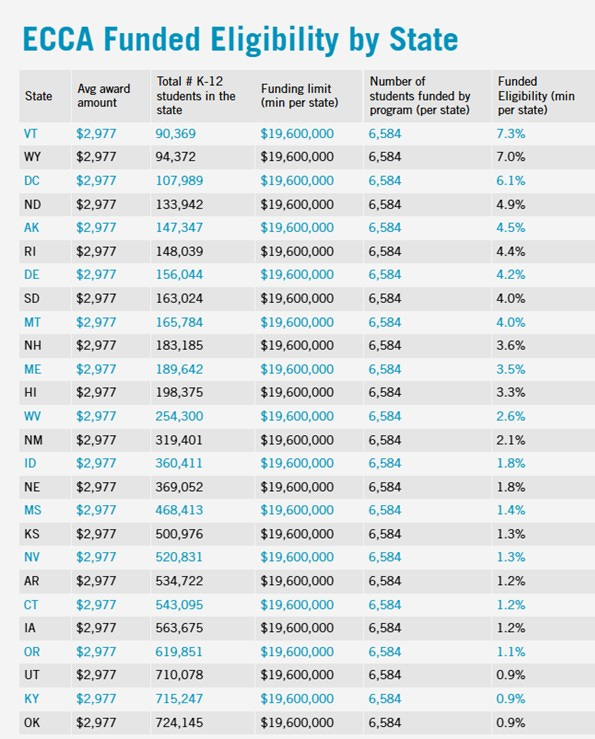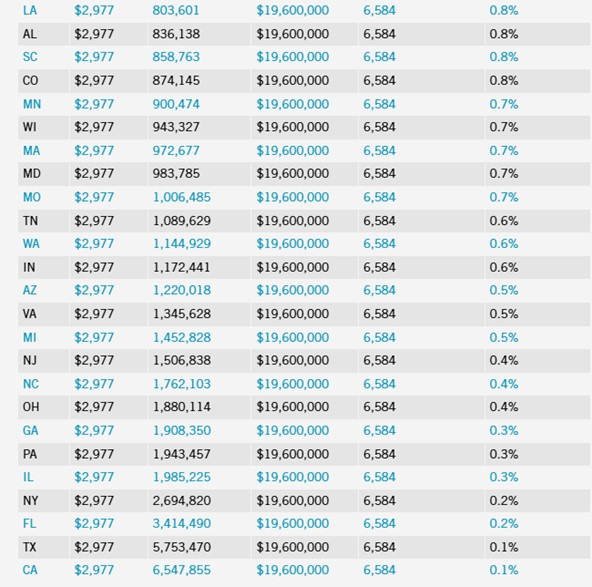How Many Scholarships Would ECCA Create?
Take up rates and scholarship sizes and donations, Oh my!
Last week in Informed Choice, Mike McShane weighed the odds of the federal Educational Choice for Children Act (ECCA) becoming law. This week, we’re doubling down by exploring the implications if the bet on ECCA pays off, estimating its funded eligibility — the number of students in each state who could receive the resources to participate — and sharing our thoughts on how ECCA funds could impact the educational choice movement.
Currently, 21 states operate tax-credit scholarship (TCS) programs that “allow taxpayers to receive full or partial tax credits when they donate to nonprofits that provide private school scholarships.” If passed, ECCA would likely become the largest tax credit scholarship in the nation by allowing individual taxpayers to get federal income tax credits when they donate to eligible scholarship granting organizations (SGOs). For individuals, the cap is $5,000 or 10% of their adjusted gross income, whichever is greater. For corporations, it's up to 5% of their taxable income.
Eligibility for students in the proposed bill language is quite vast. K-12 students in each state, regardless of school setting, are eligible. Furthermore, the income threshold is 300% of median gross income by region, which means roughly 90% of students in each state will be eligible.
Starting in 2026, ECCA would create a $10 billion volume cap on federal K-12 scholarship tax credits. The statute makes clear that 10% of the total cap shall be divided evenly among the states. The math is quite clean here. $1 billion split evenly among the 50 states (plus D.C.) means each state will have $19.6 million in tax credits available.
Using these numbers and some back-of-the-napkin calculations, we can estimate ECCA’s funded eligibility. Indeed, we find that around 6,584 students per state could access a scholarship when dividing $19.6 million by an average award amount of $2,977 (based on the average scholarship amount among existing TCS programs). Unsurprisingly, $20 million in tax credits goes much further in a state like Vermont (7.3% funded eligibility) compared to states like California or Texas (0.1% funded eligibility). The number of scholarships would, of course, go down if the average award is higher.
But let’s say a state distributes its $19.6 million in tax credits quickly. What happens next?
The remaining 90%, or $9 billion, becomes available on a first come, first served basis. The Treasury Department is expected to create and maintain an online “portal” for Scholarship Granting Organizations (SGOs) to track how much of the volume cap remains. As SGOs report contributions, the portal will update in real-time, showing how much room is left under the cap.
According to Jim Blew, co-founder of the Defense of Freedom Institute, the odds are quite low. In a recent appearance on the Fordham Institute’s Education Gadfly Show podcast, Blew said “it is very unlikely to happen. $10 billion of charitable contributions for this would go way beyond our expectations.” (Jim reached out after publication to make it clear that he meant in year one, he is confident that in subsequent years contributions should hit the $10 billion cap and trigger the escalator.)
Tempering expectations in the early years of a program of this scale makes sense. Raising awareness among individuals and corporations will take time, particularly in states unfamiliar with educational freedom. It will also take time for new and existing SGOs to start operating in states where the opportunity for tax-credit scholarships has not previously existed.
For argument’s sake, let’s assume that all $10 billion in credits are claimed. Predicting how the first-come-first-served $9 billion will be divided among states is challenging. We could assume that the states with higher adjusted gross incomes would be poised to account for a good chunk of the volume cap. Another thought could be that states with high rates of charitable giving would be quick to take advantage of this opportunity.
Alternatively, the bulk of the funds distributed could be related to knowledge of the current educational choice scene across the country. For instance, one could surmise that states with the highest take-up rates for private school choice programs would be more likely to have higher participation in ECCA than those without a private school choice program. Moreover, states already operating tax-credit scholarship programs and have relationships established with SGOs might be best positioned to take advantage of the $9 billion. This feels directionally correct, but considering the extraordinary nature of this bill, various outcomes are in play.
The figure above shows a rough estimate of what it would take to reach the $9 billion budget cap, given a range of take-up rates and average scholarship amounts. It is worth noting that we assumed that 90% of the K-12 population across the country would be eligible to participate in ECCA. With this in mind, if 1% of the eligible K-12 population decided to participate, the volume cap would not be reached unless the average scholarship amount hovered around $20,000. A take-up rate of 2% among the eligible K-12 population would require an average scholarship amount of roughly $9,000 in order to fulfill the entire volume cap. Lastly, if 3% of the eligible K-12 population decided to participate, the volume cap would be reached only if the average scholarship amount was around $6,000.
Even a 1% take-up rate in year one would be a stretch given what we know about take-up rates for private school choice programs historically. Perhaps a 1% take-up rate is too conservative an estimate considering the absence of historical context when thinking about a federal school choice program. We shall see.
Nevertheless, if ECCA is implemented successfully, millions more students could benefit from a choice program. ECCA might even open the door to educational freedom in states that have historically kept it shut. Still, significant challenges remain for the ECCA, but if it becomes law, fans of educational freedom should hope they’re dealt a good hand because ECCA might reshape the educational choice landscape for the better.









